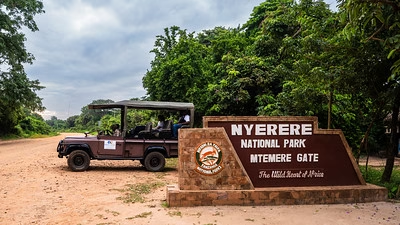Nyerere National Park.
Nyerere National Park, located in southern Tanzania, is one of the country’s largest and most ecologically significant protected areas. Originally known as the Selous Game Reserve, the park was renamed in 2019 in honor of Julius Nyerere, Tanzania’s first president and a prominent advocate for conservation and national development. Spanning over 30,000 square kilometers, Nyerere National Park is not only a haven for wildlife but also a vital part of Tanzania’s national heritage.
The park is characterized by its vast wilderness, abundant wildlife, diverse ecosystems, and significant rivers. Nyerere offers an unparalleled experience for nature lovers and eco-tourists who seek to explore the heart of East Africa’s natural beauty.
Ecological Importance.
Diverse Ecosystems
Nyerere National Park is home to several ecosystems, ranging from floodplains and woodlands to dense forests and savannahs.
These diverse habitats support a wide array of species, including many that are hard to find elsewhere in Africa. The park’s ecosystems are nourished by the Rufiji River, which flows through it, providing vital water resources for both wildlife and plant life.
Rufiji River and Wetlands
The Rufiji River is the lifeblood of the park. It is one of the largest rivers in East Africa and plays a crucial role in sustaining the park’s biodiversity.
The river and its associated wetlands are important breeding grounds for many species, including fish and waterfowl. They also support the park’s extensive populations of hippos, crocodiles, and other aquatic species.
Wildlife and biodiversity.
Big Game Viewing
Nyerere National Park is one of the best places in Tanzania to encounter Africa’s iconic “Big Five”—lions, elephants, leopards, buffalo, and rhinos. The park is renowned for its large populations of elephants, with thousands roaming freely across the park’s diverse landscapes.
Predators and Herbivores
The park is also home to large prides of lions, cheetahs, leopards, and wild dogs, offering thrilling opportunities for predator sightings. Herbivores, including buffalo, giraffes, zebras, and wildebeest, are abundant throughout the park, often grazing in the open savannah or migrating through the floodplains.
Birdlife
Nyerere National Park is a birdwatcher’s paradise, with over 400 species recorded. The park is particularly known for its abundant waterfowl and migratory species that flock to the Rufiji River and wetlands. Species like the white-headed vulture, African fish eagle, and kingfisher frequently appear.
Conservation efforts and challenges.
Anti-Poaching Initiatives
The vastness of Nyerere National Park makes it susceptible to poaching, particularly for elephants, due to the park’s rich ivory. However, Tanzania has strengthened anti-poaching measures in the region, involving both rangers and the local communities in conservation efforts.
Surveillance programs using drones and advanced technologies have been instrumental in curbing illegal activities.
Community Involvement
Nyerere National Park’s conservation strategies also include a focus on the local communities surrounding the park. Efforts are being made to involve these communities in tourism and conservation activities, providing economic incentives while ensuring that the park’s resources are used sustainably.
Sustainable Tourism
Eco-tourism in Nyerere National Park is increasingly being recognized as a vital tool for conservation. By offering guided safaris, boat trips along the Rufiji River, and walking tours, the park provides visitors with an opportunity to appreciate its rich biodiversity while contributing to conservation efforts.
Tourism in Nyerere National Park.
Safari Adventures

Nyerere National Park offers a range of safari experiences. Visitors can embark on traditional game drives to witness the park’s vast populations of wildlife, including the Big Five, as well as a variety of other mammals, reptiles, and birds.
The park’s low human population density ensures that wildlife encounters are relatively undisturbed, providing an authentic wilderness experience.
Boat Safaris on the Rufiji River

One of the park’s highlights is boat safaris along the Rufiji River. These provide a unique perspective on the wildlife of the park, offering sightings of hippos, crocodiles, and birds from the water. Boat safaris are particularly popular for birdwatching and photography.
Walking Safaris
For a more intimate experience with nature, walking safaris are available, offering visitors the chance to explore the park on foot with an experienced guide. These safaris allow tourists to gain a deeper understanding of the park’s ecosystems, from plant life to animal tracks and behavior.
Cultural Experiences
Nyerere National Park is located near several indigenous communities, including the Zaramo and Sukuma peoples. Visitors to the park can engage in cultural exchanges, where they can learn about the traditions, customs, and livelihoods of these communities, as well as their connection to the surrounding wilderness.
Challenges and the Future of Nyerere National Park.
While Nyerere National Park is a sanctuary for wildlife, it faces ongoing challenges such as poaching, human-wildlife conflict, and the pressures of climate change. However, the commitment of the Tanzanian government, local communities, and conservation organizations continues to play a significant role in safeguarding the park’s biodiversity.
Efforts are also underway to expand tourism infrastructure, including better accommodation and transportation options, which will provide tourists with a more comfortable experience while promoting conservation.
Best Time to Visit.
The best time to visit Nyerere National Park is during the dry season (June to October), when animals gather around water sources, making them easier to spot.
The rainy season (November to May) transforms the park into a lush green landscape, ideal for birdwatching and experiencing the beauty of the wetlands.
Why Visit Nyerere National Park?
Nyerere National Park is a must-visit destination for those seeking an authentic, off-the-beaten-path African safari experience.
Its vastness, coupled with the diversity of activities, ensures an unforgettable adventure. Whether you’re exploring by boat, on foot, or in a safari vehicle, Nyerere offers a chance to connect with nature in one of Africa’s most pristine wilderness areas.
Nyerere National Park stands as a testament to Tanzania’s commitment to preserving its natural heritage. With its rich biodiversity, abundant wildlife, and diverse landscapes, the park is one of East Africa’s most remarkable conservation areas. For travelers and nature enthusiasts, Nyerere offers a once-in-a-lifetime opportunity to explore the raw beauty of Africa’s wilderness while contributing to its protection.




